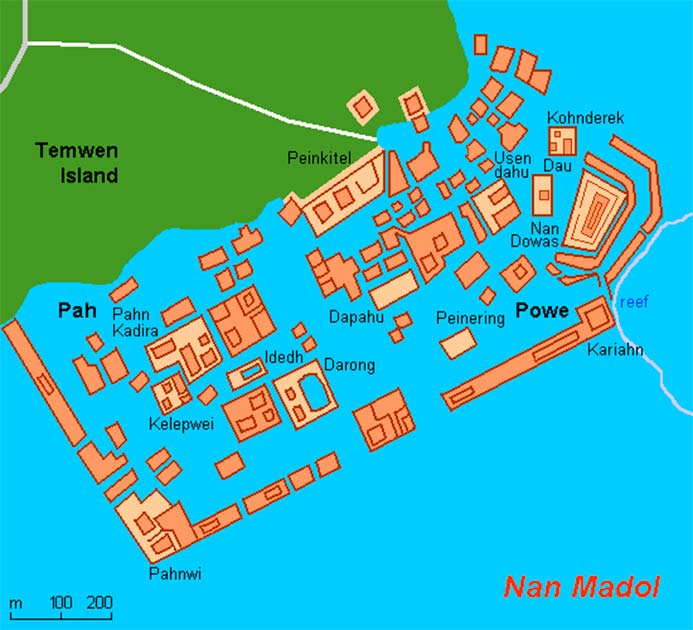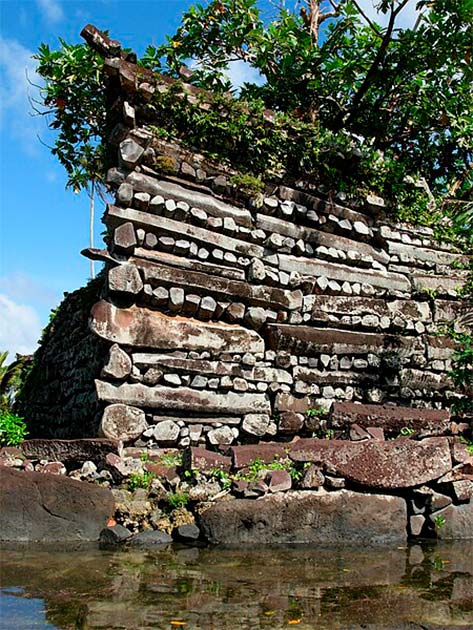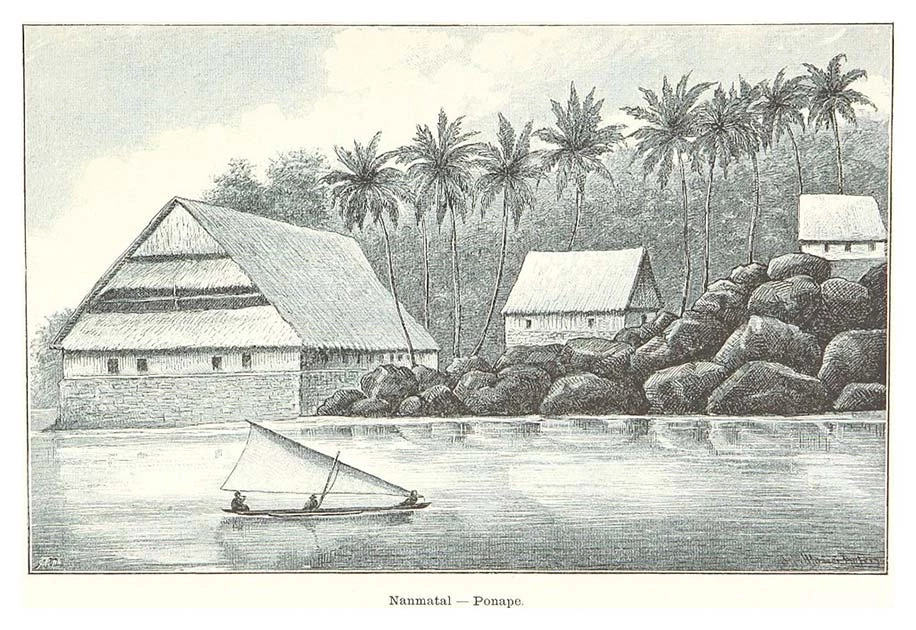Deep in the vastness of the Pacific Ocean, at the very edge of what is today known as Micronesia, lies a wonder few have ever heard of. In a lagoon at the edge of a small island lies the ruins of a stunning lost city.
Nan Madol is an impressive complex of over 90 man-made islands and structures on the eastern coast of the island of Pohnpei, part of the Federated States of Micronesia in the western Pacific Ocean. Who know it was built by the Saudeleur Dynasty in the 12th century, but otherwise this ancient city is almost entirely mysterious.
The main site is enclosed by stone walls that are around 1.5km (1 mile) long and 0.5km (0.3 miles) wide, and was built on top of a coral reef. The city is defined by its monolithic structures built from massive columns of volcanic rock.
How the city was built and why it was abandoned stumped historians for centuries, with various myths and legends claiming to hold the answers. Today, Nan Madol remains an important cultural and historical site and is recognized as a UNESCO World Heritage Site.
Land of the Sorcerer Kings
It’s believed that Nan Madol has been the scene of human activity to some extent or another since at least the first or second centuries AD. It didn’t begin to exist in its current state however until the 8 or 9th centuries. This is the point where, it is believed, construction of the islets began.

Construction of the city and its impressive structures began between 1180-1200 AD and was carried out by the Saudeleur Dynasty, who made it the ceremonial and political seat of their power. The Saudeleur Dynasty was a powerful ruling family that served as the first organized government to unite the people of Pohnpei island.
They were successful rulers, lasting from roughly 1100 to 1628 AD, but local custom states that they were not locals. Tradition holds that the Saudeleur family were from abroad since their appearance was quite different from that of the native Pohnpeians. The same customs say that the Saudeleurs started as kind, benevolent rulers but became increasingly corrupt, and demanding over time.
The island was ruled over by one ruler at a time, known as the Saudeleur, and everything from the land to its contents and even the island’s inhabitants were said to be owned by the Saudeleur ruler. This ruler leased the island’s lands to the inhabitants in exchange for frequent tributes, mainly breadfruit, and fish.
Little is known about how the impressive structures at Nan Madol were built. For centuries local consensus was that the builders of a nearby site, Leluh at Kosrae, (which is incredibly similar in structure) migrated to Pohnpei and built the city at the behest of the Saudeleur Dynasty using what they had learned at Leluh.
The problem with this theory is that radiocarbon dating suggests the opposite is true. It indicates that Nan Madol predates Leluh and that it’s much more likely the builders of Nan Madol built it first and then moved to and built Leluh.
- Who Built the Temples of Malden Island, and Where did they Go?
- Where, or What, is Aztlan, Lost Homeland of the Aztecs?
Local legends have a much more exciting answer. Pohnpei legend states that Nan Madol was constructed by two sibling sorcerers, Olishipa and Oloshpa, who came from the mystical land of Western Katau/ Kanamwayso.
These two brothers came to the island on a large canoe looking for a place to worship the god of agriculture, Nahnisohn Sahpw. Finding the site of Nan Madol to be eminently suitable, they built an altar in his honor.

The two sorcerers were said to have built the altar, and Nan Madol’s most impressive structures, by using magic and a flying dragon to levitate the giant stones. The construction took a long time and when Olishipa died, his brother, Oloshpa, became the first Saudeleur ruler. He then married a local woman and started his dynasty.
The legend then lines up with the modern understanding of the island’s history. The Saudeleur family were said to be kind rulers, to begin with, but became more demanding and corrupt over time.
Yes, but how Was Nan Madol Really Built?
The impressive structures of Nan Madol were built using heavy columns made of basalt, a dense volcanic rock that was sourced from a volcanic plug on the opposite side of the island. These columns were stabilized on the sandy seabed by using a system of coral boulders, interlocking walls, and fill material.
This would have been an incredibly time and labor-intensive process and it’s believed the construction of Nan Madol took several centuries. It would have also taken a massive degree of engineering skill as the basalt columns are far too massive, and heavy, to move through human labor alone.
Instead, it’s believed the builders of Nan Madol used a combination of human labor and a system of levers, rollers, and sleds to move the basalt column from the quarries to the construction site. Once the columns were in place, the builders used coral boulders and fill material to stabilize them on the sandy seabed and create a foundation for the structures.
At the heart of Nan Madol lies its ceremonial center. This is where the most impressive structures are. It was where the nobility of the island lived and where mortuary activities were carried out by priests. As such it had great political and religious importance.
The center most probably had a population of under 1,000 people at a time which was made up of a combination of the island’s chiefs and the commoners that served them. These chiefs came from across the island, but the Saudeleur rulers wanted to keep them all in one place, making it easier to organize and control any potential rivals.

The mortuary sector was called Madol Power and consisted of 58 islets in Nan Madol’s northeastern area. Most of the islets were inhabited by priests while others were used for food preparation, canoe building, and coconut oil preparation.
The islets of Peinkitel, Karian, and Lemkou housed tombs protected by high walls. The most important islet, however, was Nandauwas where walls 5.5 – 7.5 m (18–25 ft) high protected the royal tomb, built for the first Saudeleur ruler.
- Lost Temple of the Aegean: Where is Chryse Island?
- Sacsayhuaman: Incan Fortress or Palace of Worship?
The city center was completely reliant on the outside for fresh food and water which was gathered inland and then brought in by boat by the locals. As time went on it’s believed this reliance on the outside became the city’s undoing.
What happened to the People at Nan Madol?
Due to a lack of written records, we only have a rough idea of what happened to the Saudeleur dynasty and the Pohnpeians they ruled over. We know that around 1628 the city was attacked and conquered by a semi-mythical hero called Isokelekel who came from the nearby island of Kosrae.
There are at least 13 accounts of the war that all tell slightly different versions of the legend. Most accounts agree that by the time of the invasion, the Saudeleur Dynasty had become oppressive and abused those it ruled over. In particular, it’s believed they failed to respect local traditions and religious customs.
Local legends say that the rulers offended the Thunder God Nahn Sapwe who then, through a complicated series of events, helped Isokelekel take Nan Madol. More reliable sources simply have Isokelekel attacking the city and being aided by the local Pohnpeians, who were sick of their abusive rulers.
Whatever the truth, the Saudeleur Dynasty was followed by what’s known as the Nahnmwarki Era. This era was short-lived. The Nahnmwarkis lived at Nan Madol but soon tired of having to gather their own food and water and transporting it back to the central complex. They eventually abandoned Nan Madol and returned to where they had come from, causing the city to fall into decline.
But why didn’t the native Pohnpeians continue living at Nan Madol? No one knows for sure but environmental change may have played a significant role.
Changes in sea level, erosion, and changes in the availability of freshwater sources may have made it more difficult to maintain the city’s structures and sustain a large population. The arrival of European settlers in the region may also have contributed to the area’s decline.

Nan Madol is an enigmatic site that has fascinated archaeologists and historians for centuries. The builders of this incredible city created an impressive feat of engineering and construction that has stood the test of time.
Today, Nan Madol remains a remarkable testament to the creativity and ingenuity of the people who lived in the Pacific Islands centuries ago. The site offers an incredible insight into a lost world and is a reminder of the rich cultural and historical heritage of the region.
As we continue to study and learn more about this incredible site, we can only hope that we will uncover more of its secrets and preserve this important cultural treasure for generations to come.
Top Image: Local legend tells that the basalt columns of Nan Madol were moved by sorcery, but in truth we do not know how the city was constructed. Source: Bluesea / Adobe Stock.